Counters
OMRON provides Preset Counters, Totalizing Counters, Time Counters and Electromagnetic Counters.
| Overview | Features |
| Principles |
|
| Engineering Data |
|
Overview of Counters
What is a Counter?
The term counter is derived from the word count. It is fairly simple for people to count ten or twenty objects, but larger numbers make counting increasingly difficult. Counters outperform people when it comes to counting accurately.
For example, the devices that are used by people on street corners to count pedestrians in traffic surveys are one type of counter. They are a good replacement for people because they accurately count pedestrians and remember the count even with very large numbers.

Some game machines accurately and automatically calculate the number of items you have won. It would be a significant problem for amusement businesses if they did not count accurately.
The basketball gaming machines at amusement parks count the number of baskets made within a certain amount of time.
Even here, Counters count with high accuracy to enable the machines to display the correct number of baskets.
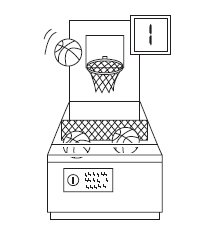
The following example shows the use of Counters in automated machinery.
Pudding Production Line
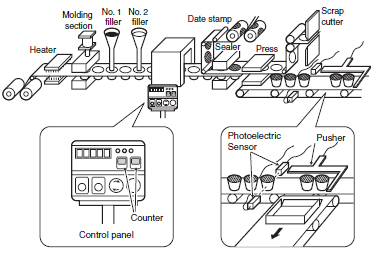
On a pudding production line, a Photoelectric Sensor detects the finished products. If the number three is preset in the Counter and it receives a Photoelectric Sensor signal three times, the Pusher (see note) pushes the three pudding containers into a box.
Note: Pusher: Pushing device
[[Preset Counter]]
The following section describes the input, control, and output signal sequence in a boxing process.
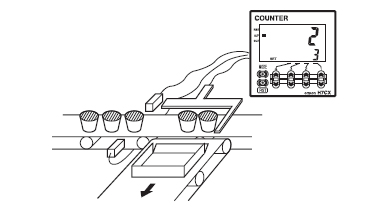
1. Input
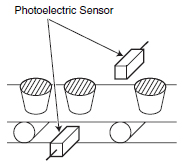
A Photoelectric Sensor is an input device that detects an object when that object blocks light. Each time the light is blocked, the Photoelectric Sensor sends a signal to the Counter.
2. Control
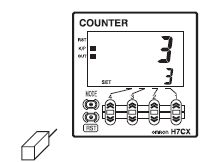
Preset the number three in the Counter. The Counter will then count the number of signals from the Photoelectric Sensor and sends a signal to the Pusher (i.e., the output device) after the Counter receives a signal for the third time.
3. Output
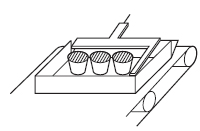
When the Pusher receives the output signal from the Counter, it pushes the three pudding containers into a box.
As you can see, the Counter is involved in every step of the input,control, and output signal sequence.
What is a Preset Counter?
A Preset Counter is a control device that counts the number of input signals until a preset value is reached. It then outputs a signal to activate the next output device.
See the following timing chart for the input and output signal timing in the boxing process for pudding.
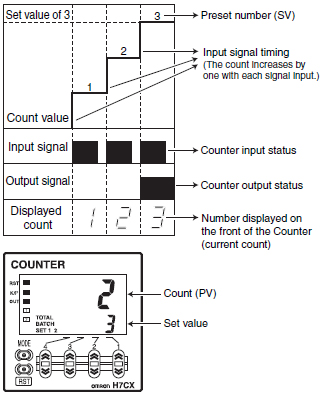
Description of the Timing Chart
1. When the first pudding container passes by the Photoelectric Sensor, the Sensor sends a signal to the Counter and 1 will be displayed.

2. When the next pudding container passes by the Photoelectric Sensor, 2 will be displayed.

3. When the third pudding container passes by the Photoelectric Sensor, 3 will be displayed. Because this number matches the set value, the Counter will output a signal.
The preset number is called the set value (or preset value). When that number is reached, a signal is output. This is often referred to counting up, but it means the same as timer setting or time up.
Basic System Configuration
H7CX Digital Counter
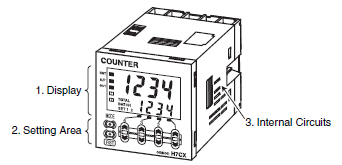
1. Display:Displays the Counter value.
2. Setting Area:Enters settings from the keys on the front panel.
3. Internal Circuits:The internal circuits count the number of input signals, compare the count to the set value, and then output a signal when the two values match.


